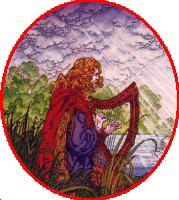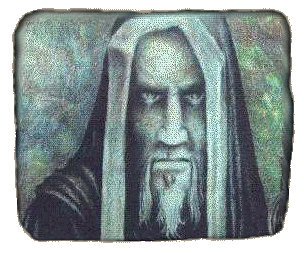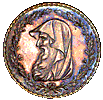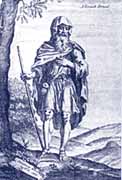|
|||||||||||||||||||||||||||||||||||||||||||||
Long before the Romans invaded Normandy, Britain and Ireland, the Celts lived in communal, tribal groups, their lives entwined with the all-pervading presence of elemental forces, and of nature itself. Among their number were an elite group of wise elders whose job it was to memorize in verse all of the knowledge and history of their tribe and pass the wisdom on by word of mouth. Often the keeping of this hidden knowledge was the traditional responsibility of certain clans or families. In this way, the family and societal histories were kept alive within the oral tradition.
With their concentrated system of learning which was known in Ireland as the Brehon Law, they grew in power and stature until they were as or more powerful than the Kings and Queens they served. Celtic Bards and Druids were allowed to pass unhindered between different warring tribes even though they were, at a later time, formally prohibited from carrying arms or using any physical weapon. But such was their position that they were capable of using words alone to vanquish their enemies when the need arose.
observing the lunar orbit around the Earth (a lunar month.) A Druid Cycle of five years was known as a 'Lustre'. At the end of six Lustres, or one month of years (30), a Druidic Cycle was complete. A period of 21 months of years corresponded to a Druidic Era. Eras dated from the Second Battle of Mag Tuireadh in Ireland, at which the Tuatha Dé Danann vanquished the Fomorians. Greek was originally known and used by the Ancient Druids until the arrival of Christianity when Latin was adopted as the new religious and scientific language. However the Druids also used a secretive hieratic alphabet as a special means of communicating with each other. It was known as the Ogham, or Beth-Luis-Nuin alphabet. It was limited to mnemonic learning by question and answer, and embodied special symbolic uses that are lost to us.
Druidic Training
|
|||||||||||||||||||||||||||||||||||||||||||||
| The
Bards (the first level of training for any of the
three paths,) were the keepers of the oral
tradition; the history of the tribe. They
memorized hundreds of stories, poems,
philosophies and Ogham, and were held in high
esteem. The greatest of the Bards was a revered
member of the King's court. While the training curriculum for bards differed in Scotland and Wales, Irish bards followed a training regimen that lasted 12 years. |
 |
The student progressed from the entry level classification of 'Principal Beginner,' during which time he carried the bronze branch, through gold branch, or 'Doctor of Poetry' status. By the time a student graduated to the level of gold branch, he or she had mastered 350 stories.
|
||||||||||||||||||||||||||||||||||||
The attributed 'branch' title referred to the type of branch carried by the Bard when entering a hall. The bardic branches had bells attached to them that would ring musically whenever the bard entered the hall to recite a poem or tale. These bells served a dual purpose: signaling to the audience that a performance was about to begin, and summoning the muses, or inner realms to empower the poem or story.
According to Ross Nichols (The Book of Druidry,)
| "All Bards are Herald Bards, who tell of noble acts, assign arms, and make prognostications. These are considerable powers to wield. They are steeply graded, and the highest grade evidently includes great originals. Members are called Princes (Privardd), who are inventors of rhythms and forms, and go by the titles of Merlin Sylvester, Merlin Ambrosius, and Taliesin. Amongst them shone the chief harpist of the land who lived in the King's palace, the Bard Telyn (Harper)." |
Ovates
The Ovates were the shamans and philosophers responsible for understanding the mysteries of death and rebirth, divining the future and speaking with the dead. Ovates studied tree lore, herbalism and healing arts, and the nature of time itself.
The druids believed in reincarnation, and the cyclical nature of life death and rebirth was integral to the studies of an Ovate. The student Ovate underwent, in the course of their training, a reorientation in awareness of time. As a shaman learned to journey through time and space to seek answers and healing, so too did the Ovate visit the realm of the ancestors; the repository of tribal wisdom, where the departed tribesmen lived while awaiting reincarnation. To these ancestors the Ovate turned for guidance and inspiration on behalf of the tribe.
Druids
The training of a Druid encompassed the levels of both Bard and Ovate, so the entire learning process undoubtedly took the greater portion of the Druid's life. Caesar stated that the training of a Druid took 20 years, but that is not known to be fact.
Druids were the ceremonial directors - the 'high priests' and philosophers of the Celtic people. The chief responsibilities and privileges of the Druid was to serve as advisor to kings and chieftains, as judge, as teacher, and as a ritual leader and authority in matters of worship and ceremony. They were also philosophers, astronomers, and mathematicians and were in general the keepers of the knowledge store of the entire society.
When the Romans invaded Britain, the Druids held out for years on their sacred Isle of Iona (present day Angsley,) directing the resistance until the Romans finally attacked the Island itself and destroyed the Druid stronghold there, killing the defenders and at last breaking the chain of Druid leadership in Celtic Britain.
Home - Frames | Home
- Non Frames | Web Rings
Bibliography | Graphic Credits | Site Fonts
Housekeeping | Contents | Guestbook
Cosmos | Calendar | Festivals | Mythology | History | Storyteller | Ritual
Shamanism | Druids | Grove | Ogham | St. Patrick | Books | Music | Links
Email me at huathe@sacredfire.net .
Gura Mi Ayd!
Copyright © 1998 The
Sacred Fire. All rights reserved.
Revised: November 17, 1998.



